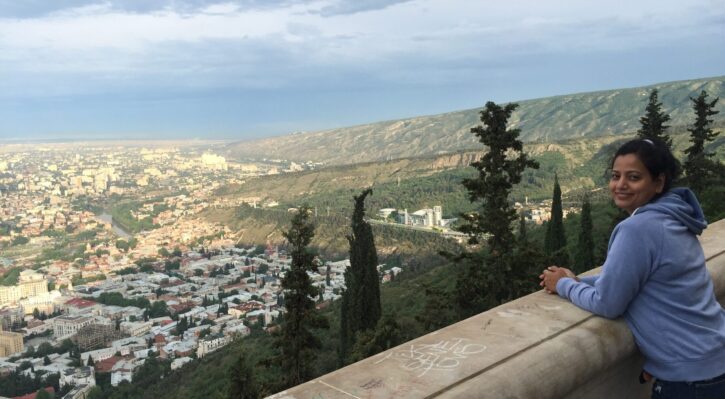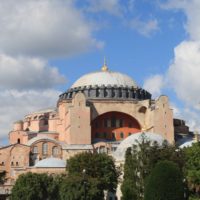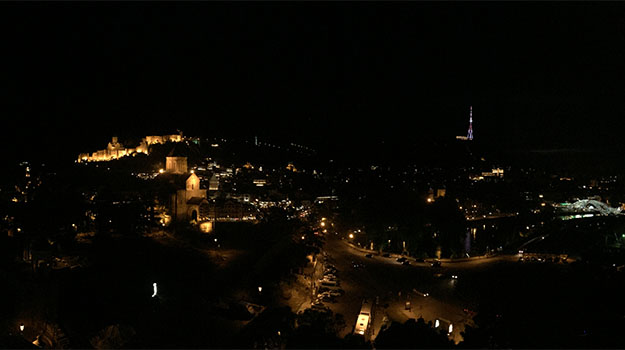A good question to ask is why has Georgia been off the tourist radar all these years, when in reality, it is one of the most beautiful countries in the Caucasus region, offering the best of Europe and Asia on a budget? I didn’t find all the answers of course, but what I do know it is that I am definitely going back some khinkali, kebab and wine!
And, considering that Georgia is one of the few countries now open to tourism, there is all the more reason for you to go!
But first, a look at Georgia
Located at the intersection of West Asia and East Europe and Black Sea to its north west, Georgia is, by far, one of the most beautiful countries in the Caucasus region, besides being the oldest wine producing countries in the world.
To start with, Georgia is NOT a part of Russia and Georgians are not Turks. Georgia is an independent country with a unique ethnic group, language and culture. Centuries of invasions by Mongols, Russians, Ottoman and Byzantines have definitely influenced their lifestyle and food, but this tiny country continues to be what it was – true to its roots.
Tbilisi, Georgia’s capital is a destination in itself – with enough to keep a visitor occupied for a day, two or more. I asked to be excused for gushing – but when I arrive in a country that doesn’t charge a Lari for a visa, you can be sure of my falling rapidly and deeply in love, irrespective of what I was going to encounter outside.
To begin with – is Gerogia safe? Well, yes, it is very safe to travel, whether solo or as family. The locals are happy go lucky sort of people and very friendly. That said, you must naturally exercise caution when carrying large amount of cash or even jewelery, just as you would in any other place.
North for adventure
From the word go, there was so much waiting to be explored and without wasting time, I hired a car (with a driver, of course and I will tell you why) and headed north through the Georgian Military Highway that led into Russia. The Georgian side ends at Stepantsminda (former Kazbegi) just short of Russian border. Unmistakable signs of ancient habitation appear at vantage points, such as the Jvari Monastery perched on an outcrop overlooking the UNESCO World Heritage town of Mstshekta (the famous cave dwelling of Uplistsikhe are located around here), the Zhinvali Reservoir and the confluence of Black and White River Aragvi. Suffice to say that it is the first indication of beautiful things to come in this country.
As I headed further uphill towards Gudauri, paragliding, hiking and skiing were just a few things the driver-guide said I could do, season permitting, although hiking was a definite possibility all year through.
Driving past Gudauri towards Kazbegi, is the Friendship Monument, built in 1983 to celebrate friendship between Russia and Georgia. Covered in colourful murals, this circular wall is perched on the edge of a cliff and is a hit amongst the camera-happy tourists looking for a memorable photo and locally procured fruits Georgians are very proud of.
Hence when we reached Stepantsminda, it was late, so I spent my time reveling in the tiny border town that consisted primarily of one museum, two hotels and four cafes overlooking the town centre with snow-covered mountains rising out of their backyard. It was in this jewel of a town that I found Georgia best kharcho soup and kebab. Thanks to this culinary gem, the night passed away peacefully.
It began to rain the next morning, which meant hiking to the mountain top to pay my respects at the Gergeti Trinity Church was out of question, so it was a 4WD once again and we bumped along dangerously up the steep incline to reach 2170m above the village of Gergeti.
The 14th century Gergeti Trinity Church is worth the trip for two reasons – it is a very old church and two, the views from the mountain top is breathtaking. Snow-capped mountains rise above behind the church and the village of Gergeti appears like a distant fairyland below! Click away to your heart’s content because there are not many places in Georgia that can satisfy our soul as much this mountain top.
Things to know: Skiing season at Gudauri is from December – April. If you are an adrenaline junkie, time your visit to coincide with the ski season. Paragliding however can be done on any day when the weather is good. Most hotels remain closed in the non-skiing season.
Go east for heritage
One the eastern side of Georgia is the Kakheti region and here is Sighnaghi, the walled city, reachable via stunning landscape and vineyards. When driving through pull over at the numerous vineyards for some delicious fruit and enjoy delicious wine – in fact this is a very popular wine route, with plenty of wineries along the way offering free sampling. This region has over 300 varieties of grapes, most of it used for making different kinds of wine. My favourite of them all was Kindzmarauli, a semi-sweet dark red wine that complemented the fine kebabs I ended up eating at all meals during my stay.
Kakheti is known for its monasteries, like the Bodbe Monastery where the body of Saint Nino’s (Enlightener of Georgia) is buried. The monastery overlooks a beautiful valley and you can look into Azerbaijan on a clear day. Inside the monastery, women are expected to cover their head and photography is strictly not allowed, although the beautiful paintings on the walls are a temptation, avoid breaking rules. St. Nino is much revered by Georgians.
The eastern region of Georgia – Kakheti, is fast becoming a major tourist draw. Kakheti has some un-missable attractions and a landscape that beats any European country side. Easily reached from Tibilisi (in under 1.5 hours if you are driving yourself), this is also Georgia’s wine capital.
Highlights:
Signaghi is the prettiest town in this region, sitting on a hilltop overlooking beautiful green Alzani. Walking down the road you could for a moment feel yourself in Italy – the town has been renovated not too long ago and the streets are quite new – but they have easily managed to retain much of the old world charm. The 4500m City Wall surrounding the city was built in the 18th century by King Erekle II, to protect the area against attacks. Sighnaghi’s fortifying wall is one of the biggest in Georgia, ruined in some parts but restored recently and is open to tourist intending to walk on them. David Gareja is a monastery complex high in the mountains (bordering Azerbaijan) cut into a single big rock. It is not easily accessible but if you brave the elements to reach here, you are going to be treated to some history and fantastic scenery.
Tibilisi, a city with a heart
Georgia was among the first few countries to adopt Christianity as the official religion and it goes without saying that it is home to some beautiful churches build hundreds of years ago and many of them can be found in Tibilisi. It’s a great way to see glimpse the past. Tibilisi also does a great party-scene, pulsating with life till late hours when it turns into a party-hotspot, challenging every notion you have about nightlife in this tiny mountainous country. The Georgians know how to wear their party shoes – and if you are looking for a great night out, your best bet would be to head to Rustaveli to rub shoulders with some lively and artsy crowd. At night, stroll through the city, in particular through the recently built Bridge of Peace (strictly for pedestrians) which lights up in different colours at nightfall. I have heard a few locals refer to it as an “eye sore”, but I suppose the beauty lies in the eye of the beholder!
Food in Georgia
If you do not want to experiment with food, just stick those that start with letter K – Khachapuri, Khinkali, Kharcho (thick soup) and kebab. For the uninhibited, just order off the menu because you can’t go wrong with food in Georgia. Remember that every meal is accompanied by a beverage, but it is totally up to you to indulge.
Here is a quick note about eating khinkali. This delicious ‘dumpling’ arrives steaming HOT on a plate. Add a dash of pepper. Do not reach for the fork, spoon or knives, instead hold it up by the stem and use the other hand to hold the base. Then bite into the fleshy base and quickly suck the liquid inside, lest it drop. Once you have sucked it dry, make your way upward towards the stem. Remember, you must not eat the stem. In Georgia eating the khinkali stem can bring you shame!
When in Tibilisi –
- Dine at a local restaurant to see the real Georgian life closely. Family restaurants, generally on the weekends, hosts cultural shows and as you dine in large, Russian-styled dining halls, you can catch a dance show and some fabulous singing.
- Ride the funicular to Mtatsminda for some breathtaking views of the city. Don’t miss the peculiar “leaning houses”.
- Take a sulphur bath in Tibilis’s Old Town right below the Narikala Fortress. Nothing like a soak in the suplhur springs to make you fall in love with Tibilisi.
Handy Tips
Taxis are easily available, but fix the correct far before you start.
Metro connects with the important sections of the city.
For out of town travel, there are marshrutkas – and the rates are very reasonably priced.
Taxis are available at the airports and not very expensive as the airport is not that much far away from the city centre.







Planning to visit Georgia. Thanks for the excellent guide.